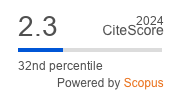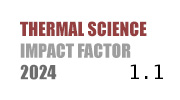THERMAL SCIENCE
International Scientific Journal
Thermal Science - Online First
online first only
Forecasting indoor nitrogen-dioxide concentrations in a student dormitory using RNN-LSTM models
ABSTRACT
Air quality has a profound impact on the urban environment, with both positive and negative effects. Developing effective strategies for improving and predicting air quality is crucial for urban environmental management. This study was conducted from June 2021 to March 2022, with a sample size of 584. The study collected air quality data from dormitory buildings, including indoor temperature, wind speed, humidity, and nitrogen dioxide (NO₂) concentration. Additionally, we conducted a qualitative analysis to explore the relationship between atmospheric parameters and average NO₂ concentration. We compared MLP with recurrent neural networks (RNN) and long short-term memory (LSTM) models for optimization in predicting NO₂ concentrations. Experimental results showed that the combination of RNN and LSTM significantly improved the accuracy of NO₂ concentration predictions. This study provides important references for monitoring NO₂ concentrations in university dormitories and improving air quality.
KEYWORDS
PAPER SUBMITTED: 2025-06-02
PAPER REVISED: 2025-07-25
PAPER ACCEPTED: 2025-08-01
PUBLISHED ONLINE: 2025-09-13
- Roser, Max. "Data review: how many people die from air pollution? " Our world in data (2024)
- Ayturan, et al. (2018). Air Pollution Modelling with Deep Learning: A Review. 1. 58-62
- Kai-Fa Lu, et al, Characterizing temporal and vertical distribution patterns of traffic-emitted pollutants near an elevated expressway in urban residential areas, Building and Environment, Volume 172,2020,106678, ISSN 0360-1323
- Tang Zhixiang. Research and implementation of air quality prediction based on BP neural network [D]. Xi'an Electronic Science and Technology University,2018
- N.E. Klepeis, et al, The national human activity pattern survey (NHAPS): a resource for assessing exposure to environmental pollution, Expo, Anal. Environ. Epidemiol. 11 (2001) 231-252
- T. -H. Chan, et al, "PCANet: A Simple Deep Learning Baseline for Image Classification?" inIEEE Transactions on Image Processing, vol. 24, no. 12, pp. 5017-5032, Dec. 2015, doi: 10.1109/TIP.2015.2475625
- A. -r. Mohamed, et al, "Deep Belief Networks using discriminative features for phone recognition,"2011 IEEE International Conference on Acoustics, Speech and Signal Processing (ICASSP), Prague, Czech Republic, 2011, pp. 5060-5063, doi: 10.1109/ICASSP.2011.5947494
- Hao, et al. (2016). Deep learning. International Journal of Semantic Computing, 10(03), 417-439
- Chang, et al, An LSTM based aggregated model for air pollution forecasting, Atmos. Pollu. Res. 11 (2020) 1451-1463
- X. Gao, W.D. Li, A graph-based LSTM model for PM2.5 forecasting, Atmos. Pollu. Res. 12 (2021) 101150
- D. Seng, et al, Spatiotemporal prediction of air quality based on LSTM neural network, Alex. Eng. J. 60 (2021) 2021-2032
- R. Yan, et al, Multi-hour and multi-site air quality index forecasting in Beijing using CNN, LSTM, CNN-LSTM, and spatiotemporal clustering, Expert Syst. Appl. 169 (2021) 114513
- B. Zhang, et al, A novel Encoder-Decoder model based on read-first LSTM for air pollutant prediction, Sci. Total Environ. 765 (2021) 144507
- Rui Zhang, et al Predicting the concentrations of VOCs in a controlled chamber and an occupied classroom via a deep learning approach, Building and Environment, Volume 207, Part B,2022,108525, ISSN 0360-1323
- Li, et al, 2017b. Long short-term memory neural network for air pollutant concentration predictions: method development and evaluation
- Xue, et al. District Heating Load Prediction Algorithm Based on Feature Fusion LSTM Model.Energies2019,12, 2122
- Xing cheng Lu, et al, Development and application of a hybrid long-short term memory - three dimensional variational technique for the improvement of PM2.5 forecasting, Science of The Total Environment, Volume 770,2021,144221, ISSN 0048-9697
- HAN Wei, WU Yan lan, REN Fu. Air pollutant prediction based on fully connected and LSTM neural networks[J]. Geographic Information World,2018,2503:34-40
- Cheng liang Xu, et al, Improving prediction performance for indoor temperature in public buildings based on a novel deep learning method, Building and Environment, Volume 148,2019, Pages 128-135, ISSN 0360-1323
- Hochreiter, S., Schmidhuber, J., 1997. Long short-term memory. Neural Comput. 9,1735e1780
- F.BIANCOFIORE, M.BUSILACCHIO, M.VERDECCHIA, et al. Recursive neural network model for analysis and forecast of PM10 and PM2.5[J]. Atmospheric Pollution Research,2017,8(4):652~659
- Krishan, M., Jha, S., Das, J.et al. Air quality modelling using long short-term memory (LSTM) over NCT-Delhi, India. Air Qual Atmos Health12, 899-908 (2019)
- Zheng Yangyang, et al. Application of Keras-based LSTM model for air quality index prediction[J]. Practice and Understanding of Mathematics, 2019(7):6. DOI:CNKI:SUN:SSJS.0.2019-07-017
- Jie HUANG, et al. Hourly concentration prediction of PM2.5based on RNN-CNN ensemble deep learning model. Journal of Zhe Jiang University (Science Edition), 2019, 46(3): 370-379
- Kristiani, E.; et al. Short-Term Prediction of PM2.5Using LSTM Deep Learning Methods.Sustainability2022,14, 2068
- Bihter Das, Ömer Osman Dursun, Suat Toraman, Prediction of air pollutants for air quality using deep learning methods in a metropolitan city, Urban Climate, Volume 46,2022,101291, ISSN 2212-0955
- Kim, J.; et al. Development of a Deep Learning-Based Prediction Model for Water Consumption at the Household Level.Water2022,14, 1512
- Apeksha Aggarwal, Durga Toshniwal, A hybrid deep learning framework for urban air quality forecasting, Journal of Cleaner Production, Volume 329,2021,129660, ISSN 0959-6526
- Freeman, et al, J. (2018). Forecasting air quality time series using deep learning. Journal of the Air & Waste Management Association,68(8), 866-886
- Patricio Perez, et al, PM2.5 forecasting in Coyhaique, the most polluted city in the Americas, Urban Climate, Volume 32,2020,100608, ISSN 2212-0955
- R. Janarthanan, et al, A deep learning approach for prediction of air quality index in a metropolitan city, Sustainable Cities and Society, Volume 67,2021,102720, ISSN 2210-6707
- Al-Janabi, S., Mohammad, M. & Al-Sultan, A. A new method for prediction of air pollution based on intelligent computation. Soft Comput24, 661-680 (2020). doi.org/10.1007/s00500-019-04495-1
- Bekkar, A., Hssina, B., Douzi, S.et al. Air-pollution prediction in smart city, deep learning approach. J Big Data8, 161 (2021). doi.org/10.1186/s40537-021-00548-1
- Suh. Research on air quality prediction based on improved BP neural network[D]. Nanchang University,2020
- FAN Junxiang, et al. Research on air pollution spatio-temporal forecasting model based on RNN[J]. Surveying and Mapping Science,2017,4207:76-83+120
- Tello-Leal, et al. Evaluation of Deep Learning Models for Predicting the Concentration of Air Pollutants in Urban Environments.Sustainability2024,16, 7062. doi.org/10.3390/su16167062
- YANG Li, et al. A review of recurrent neural network research[J]. Computer Applications,2018,38S2:1-6+26
- Xie Chongbo. Research on urban air quality prediction based on recurrent neural network[D]. Southwest University of Science and Technology,2019
- HAN Wei, et al. Air pollutant prediction based on fully connected and LSTM neural networks[J]. Geographic Information World,2018,2503:34-40

